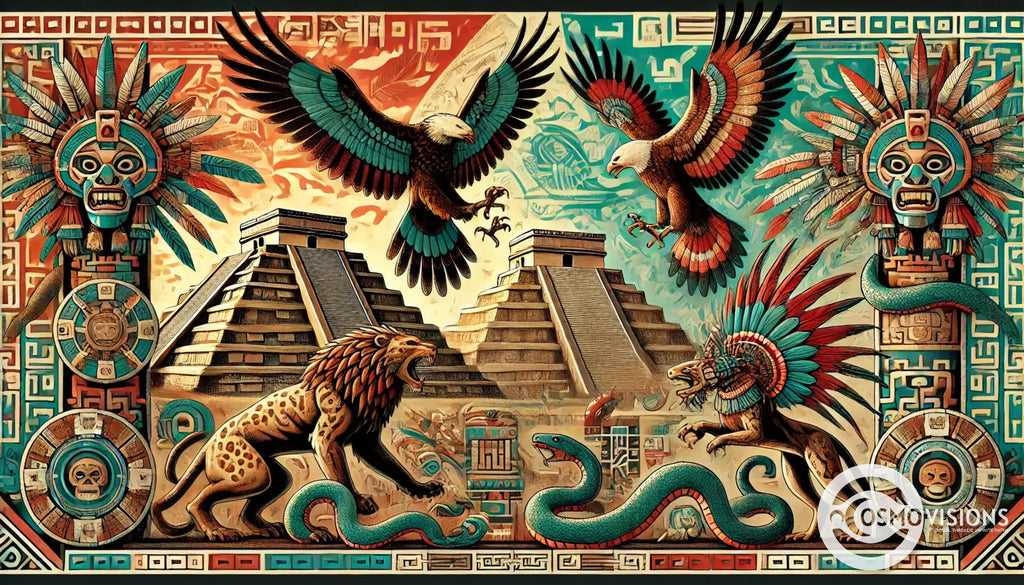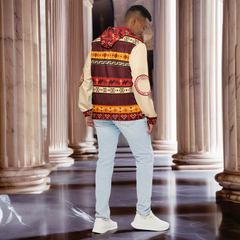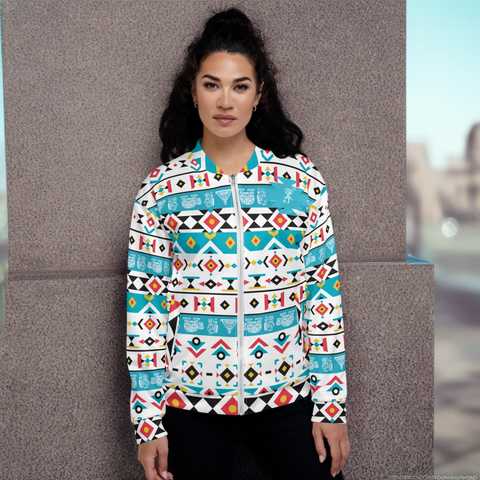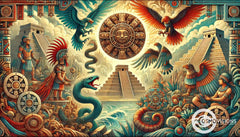Unlocking the Power of the Aztec Strength Symbol: Meaning and Significance
Posted by Massimiliano Geraci

Many people around the world are fascinated by ancient civilizations and their profound wisdom, particularly focusing on symbols that carry deep meanings of strength and power. The Aztec civilization is renowned for its rich mythology and symbolic language, which has captivated the hearts of anthropology enthusiasts, spirituality seekers, and lovers of indios art.
One symbol stands out for its significance: the Aztec symbol for strength.
This emblem embodies a complex tapestry of meanings interwoven with elements from nature such as eagles, jaguars, serpents, and feathers—all revered in Aztec culture for their power and majesty.
By examining the roots of this ancient symbology, our article sheds light on how these icons represented resilience, courage, and vigor among the Aztecs. Through exploring warrior culture depictions like Jaguar Warriors to divine representations like Quetzalcoatl—the Feathered Serpent deity—readers will gain insights into how strength was envisioned by this fascinating Mesoamerican society.
Prepare for a journey through time as we decode these venerable symbols. Explore with us.
What is the Aztec Symbol for Strength?
The Aztec civilization, deeply rooted in Mexico, revered various symbols and images to depict strength, power, and resilience among the Mexica people. A paramount symbol within this ancient culture was the jaguar, embodying ferocity and valor.
Esteemed as one of the fiercest predators in many Mesoamerican cultures, the jaguar signified more than mere physical might; it represented spiritual authority and command over cosmic aspects.
These majestic creatures adorned temples and war attire, reminding warriors of their duty to mirror such formidable traits on battlefields.
Eagles also held a significant place alongside jaguars in representing strength within Aztec society. Majestic birds soaring high above denoted divine favor and martial prowess, connecting warriors with Huitzilopochtli—the god of war and sun—guiding them to victory with their sharp vision and indomitable spirit.
As symbols in Aztec mythology transform into modern interpretations reflecting ancient wisdom about resilience amid adversity.
In our veins flows the blood of Mexican ancestors; we inherit their dreams carved into stone.

Understanding the Aztec Symbolic Language
Aztec symbolic language serves as a rich tapestry of mythology, spirituality, and daily life intricacies, interweaving symbols that span from the natural world to the divine. Symbols such as jaguars, eagles, and serpents were not just artistic expressions but also held deep-rooted meanings related to strength, power, and renewal.
These motifs found throughout Aztec culture—from temple walls in Tenochtitlan to the intricate designs of warrior shields—communicate complex concepts without words. They symbolize important religious beliefs and societal values, reflecting a civilization deeply connected with nature's cycles and the metaphysical dimensions.
Symbols like the obsidian butterfly represent transformation and rebirth, while depictions of gods such as Tezcatlipoca and Quetzalcoatl embody attributes of leadership, fertility, and creativity.
Through detailed sculptures and geometric shapes decorating their sacred spaces, Aztecs conveyed stories of creation, warfare strategies like those employed by elite warriors (jaguar warriors), principles governing celestial bodies' movements aligning with their calendar system.
Each symbol acts as a vessel carrying centuries-old wisdom from this highly skilled society that once thrived in Mexico’s valleys. Guided by these profound symbols engraved on artifacts left behind by the Aztecs also supports modern interpretations connecting past with present cultural practices in modern day Mexico.
This examination into Aztec symbolism reveals how they used imagery not only for decoration but also to honor deities associated with natural phenomena or human endeavors crucial for their survival which transitions seamlessly into exploring "The Role of the Jaguar in Strength Symbolism.".
The Role of the Jaguar in Strength Symbolism
Moving beyond the basics of Aztec symbolic language brings us to the majestic jaguar, a creature that played a pivotal role in embodying strength and power within Aztec culture. The jaguar was one such important symbol, revered for its prowess and associated with elite warriors known as Jaguar Warriors.
These fierce fighters adorned themselves in jaguar skins, aiming to channel the animal's formidable strength and agility into their own capabilities on the battlefield.
This admiration wasn't superficial; it stemmed from deeply held beliefs about the natural world's influence on human endeavors. For the Aztecs, incorporating images of jaguars into their art, rituals, and mythology was a way to harness this powerful animal's spirit. The cardinal directions became one of the most important Aztec symbols, with their meanings associated with both their aztec empire and their religion.
They saw parallels between the jaguar’s mastery over its domain and an ideal warrior's dominion over his enemies. Illustrations of these magnificent beasts often decorated temples and sacred spaces throughout Tenochtitlan, paying homage to their significant role as protectors against spiritual darkness while also signifying strength and authority.
This practice served not just as an artistic expression but as a vivid reminder of the warrior ethos that permeated every aspect of Aztec society.
Depictions of Strength in Aztec Culture
In Aztec culture, strength did not solely reside in physical prowess but was intricately woven into their spiritual beliefs and daily practices. The Aztecs revered gods such as Tezcatlipoca, who personified the night sky and played a critical role in battles and victories, showcasing the divine aspect of strength.
Warriors were esteemed not just for their combat skills but for embodying qualities like bravery and sacrifice, symbolized through rituals involving human sacrifice to pay homage to deities.
Such acts illustrated a profound connection between the mortal world and the divine, where strength transcended mere physicality to encompass moral courage and spiritual dedication.
Aztec warriors, particularly Jaguar warriors or Eagle knights, wore skins or feathers representing their namesake animals, further embedding the symbolism of animal might into human endeavors. The Aztecs were composed of several ethnic groups from the region. Most, but not all, were speakers of the Nahuatl language.
These depictions served as reminders of the warrior's alignment with powerful forces of nature. As symbols permeated various facets of Aztec life—from temple carvings illustrating mythic heroes to everyday objects adorned with icons honoring gods like Quetzalcoatl—the serpent deity intertwined with cultural identities signifying wisdom alongside power.
This comprehensive portrayal underscores how depictions of strength saturated every layer of society, marking an indelible link between earthly beings and celestial powers.
Next explored is why eagles held iconic status among these representations—a transition from terrestrial dominions to aerial sovereignties within Aztec symbolism.

Why is the Eagle Considered a Symbol of Strength in Aztec Culture?
The eagle holds a revered spot in Aztec mythology, symbolizing power and strength. This majestic bird is closely linked to the aztec sun god Huitzilopochtli, embodying celestial force and vitality.
Aztecs envisioned eagles as divine messengers, soaring between the earthly and the heavens with messages from the gods. Such beliefs underscored their importance in rituals and iconography, often depicted gripping a snake in its beak—a powerful image encapsulating triumph over chaos.
Aztec warriors aspired to gain the eagle's formidable attributes by adorning themselves with its feathers and emblems during battle. These warrior eagles were elite fighters, exemplifying bravery, honor, and prowess on the battlefield.
Their symbolic association with this regal bird was not just decorative but served to invoke the eagle's might and spirit into their very essence. Through this spiritual embodiment of the eagle's characteristics, Aztec culture celebrated these warriors for their vital role in protecting Tenochtitlan—their capital—and preserving the values held dear by their society.
The Power of the Eagle in Aztec Mythology
Eagles held a vital position in Aztec mythology, embodying strength, courage, and freedom. These majestic birds were not just creatures of the sky but also powerful symbols that connected the earthly world to the divine.
Their representation was so influential that Aztec warriors aspired to possess qualities like an eagle; soaring high with bravery and fierce determination. In the rich tapestry of Aztec cultural history, eagles are frequently depicted alongside important figures in Aztec mythology and within the intricate designs found throughout Tenochtitlan, illuminating their significance beyond mere animals to becoming emblems of spiritual and martial might.
In ceremonies dedicated to the sun god, eagles signified renewal and resurrection—themes central America to many Mesoamerican beliefs including those surrounding reincarnation and the cycle of life and death.
Warriors who embodied the eagle spirit were considered close confidants of gods like Tezcatlipoca and Quetzalcoatl, gaining favor through acts that mirrored the bird’s formidable nature.
This intertwining of mythological reverence with societal roles underscores how deeply respect for this creature penetrated Aztec society, elevating it from a symbol seen in battle regalia or temple walls to an essential aspect guiding principles on valor, leadership, and divine connection among the Aztec people.
Aztec Warrior Eagles: Important Symbols of Power
In Aztec culture, the Warrior Eagles stood as towering symbols of power and strength. These elite warriors, cloaked in feathers and bearing the likeness of their namesake, epitomized the martial prowess and spiritual fervor that drove the Aztec military machine.
Trained from a young age in the arts of combat and strategy within the bustling streets of Tenochtitlan, these fearsome fighters were not only skilled warriors but also held an important role in ceremonial practices.
They captured foes for sacrifice to ensure cosmic balance and favor from the gods, embodying both dread and reverence across Mesoamerica.
Their regalia was carefully crafted to invoke the spirit of the eagle - a creature soaring above all, fearless and relentless. This symbolism deeply rooted in Aztec mythology tied them directly to Huitzilopochtli, their aztec sun god, who guided their conquests with divine providence.
The imagery surrounding these warrior eagles fed into broader cultural narratives about strength, courage, and divine mandate that shaped every aspect of life in ancient Mexico from warfare tactics to spiritual ceremonies.
Through this embodiment of celestial might, Aztec Warrior Eagles served not just as soldiers but as living conduits between heaven and earth.
As carriers of both spear and shield, they marched forth under Huitzilopochtli's watchful eye - guardians of Tenochtitlan's legacy.
How Do Aztec Symbols Represent Strength in Warrior Culture?
Aztec warriors earned their ranks through acts of bravery and skills in battle, symbolized by the prestigious titles of Jaguar and Eagle warriors. These symbols were not decorative but carried profound meanings tied to strength, agility, and dominion over land and sky.
The jaguar, revered for its powerful stature and stealthy prowess, mirrored the warrior's terrestrial supremacy. Eagles, soaring high with keen sight and lethal precision, epitomized control over the spiritual sphere.
Both animals were integral in Aztec war strategy as they encapsulated the essence of conquest—dominance on earth as well as spiritual guidance from above.
Symbols carved into Tenochtitlan's architecture further displayed this martial vigor. Feathered serpents adorned temple walls, marrying earthly power with celestial wisdom—a reminder that strength sprang from both physical might and divine favor.
Through these depictions, Aztecs communicated a message across time: to understand Aztec warrior culture is to see strength as multifaceted—rooted in physical prowess supported by spiritual endorsement.
This symbology was woven throughout their societal fabric, reflecting an intricate relationship between warfare tactics employed by Aztecs and deities’ guidance supporting victories large enough to secure a legacy spanning centuries past their civilization’s zenith until modern interpretations bring it afresh to audiences worldwide.
The Significance of Jaguar Warriors
Jaguar warriors, revered as the elite soldiers of the ancient Aztec capital Tenochtitlan, held a prestigious position in military and religious hierarchies. They earned this esteemed status through demonstrated bravery and martial prowess in numerous battles.
Clad in jaguar skins, these formidable fighters embodied the strength and ferocity of the jaguar god Tezcatlipoca, one of the principal deities linked with power and warfare. Their appearance was crafted not only for battlefield effectiveness but also to invoke fear in their enemies, projecting an image of supernatural beings sprung from myth into reality.
These warriors played critical roles during sacred rituals and ceremonies, acting out cosmological beliefs that were foundational to Aztec spirituality. The souls of jaguar warriors were believed to ascend to a glorious afterlife alongside those of other valorous individuals such as women who died in childbirth—a belief reflecting their paramount significance within society.
Through acts of courage, they captured prisoners for sacrifice, ensuring the sun's rebirth each morning—an act vital for maintaining cosmic order and securing agricultural fertility symbolized by maize goddesses like Itzpapalotl.
Symbols in Aztec Temple and War
At the core of Aztec culture, temples and battlegrounds were adorned with symbols that spoke volumes about their spiritual and martial values. The eagle, embodying power and foresight, was not just a revered creature but also a symbol for Aztec warrior eagles, an elite group esteemed throughout the aztec empire.
These warriors wore costumes that mimicked the bird’s majestic features, believing this would imbue them with the eagle's formidable strength and honor in war.
Echoes of these ancient practices resonate in contemporary Mexican culture where symbols derived from Aztec mythology continue to hold significance. For instance, the image of an eagle perched on a cactus is central Mexico to Mexico’s national flag, encapsulating stories of migration and destiny deeply rooted in mythical narratives.
This emblem reflects how motifs from Aztec temples and wars have traversed time to remain potent symbols of identity and resilience among modern descendants.
The Role of Feathered Serpents in Strength and Power
Feathered Serpents, embodying the revered god Quetzalcoatl, hold a pivotal place in Aztec mythology, symbolizing strength and power. These majestic creatures bridge the earthly world with the divine, offering insight into the Aztecs' deeply spiritual understanding of power dynamics.
The depiction of Quetzalcoatl highlights a connection to the divine and emphasizes the importance of wisdom and wind as elements intertwined with strength. This deity's representation across various mediums—temples, art, and literature—underscores its significance in guiding warriors and rulers alike toward enlightened leadership and strategic prowess.
The imagery associated with feathered serpents extends beyond mere decoration; it serves as a reminder of the balance between physical strength and intellectual might required for true leadership within Aztec culture.
As symbols used by the Aztecs throughout time, these icons are encoded messages about harnessing both terrestrial and celestial forces. Leading from this notion is an exploration into how feathers themselves play a role beyond their aesthetic appeal, exploring their symbolic contribution to conveying power within sacred ceremonies.
What is the Meaning Behind the Feather in Aztec Symbols?
Feathers play a critical role in Aztec symbols, embodying power and the divine connection between the earth and the sky. To the Aztecs, feathers were not just ornamental; they signified strength, nobility, and spiritual ascent.
Highly valued feathers, like those of the quetzal bird, linked to gods such as Quetzalcoatl—the Feathered Serpent deity—illustrate this sacred association. Each feather worked into clothing or worn by High Priests during ceremonies transcended mere decoration to become a symbol of communication with higher powers.
In every feather lies the breath of the divine, a bridge between worlds.
Aztec warriors earned feathers through acts of bravery and skill in battle, marking their accomplishments and serving as tangible links to their spiritual patrons. This practice highlighted how integral feathers were within both societal status and personal achievement.
Such elements were prevalent across various activities from war paint to ceremonial dances, where wearing these powerful emblems brought favor from gods and ancestors alike. The importance placed on these items demonstrates how deeply interwoven material culture was with spirituality in Aztec life—a testament to beliefs that elevated natural objects into profound meaning.
Feathers and Their Symbolic Representation of Power
In Aztec culture, feathers serve as potent symbols of power and spiritual might. Warriors adorned in feathered headdresses called upon the divine favor, channeling strength and protection from the gods during fierce battles.
These feathers, often plucked from revered birds like eagles and falcons, embody the celestial bond between humanity and deities. Through this sacred adornment, Aztecs communicated their status as formidable opponents on the battlefield, capable of harnessing both earthly and cosmic forces.
Ceremonies teemed with feathers accentuated their role in connecting mortals to the spiritual world. Priests donned elaborate costumes festooned with feathers during rituals to invoke guidance from goddess Itzpapalotl and other deities.
Such practices underscored a belief system where power transcended physical boundaries, linking souls across celestial divides. Feathers in Aztec society were not mere decorations; they symbolized a conduit for divine strength, ensuring warriors’ prowess was magnified by spiritual allies.
Importance of Feathers in Aztec Ceremonies
Feathers played a pivotal role in Aztec ceremonies, symbolizing the connection between earth and sky. Priests adorned themselves with vibrant plumes during religious events to embody the gods they invoked, bridging the human world with divine domains.
This practice underscored their belief in the power of these celestial beings to influence day-to-day life and critical decisions. Such garments, often made from feathers of revered birds like eagles and quetzals, were not only ornamental but served as vectors for spiritual communication and favor.
These sacred adornments also marked significant moments within the Aztec calendar, enriching rituals that celebrated cycles of life, death, and rebirth. Warriors earned feathers through acts of bravery and skill—tangible honors that spoke volumes about valor and divine protection.
Through ceremonies steeped in this visual lexicon of strength and guidance, Aztecs communicated deeply held values across generations. Feathers thus became essential mediums through which spirituality was expressed, connecting individuals with larger cosmic forces while grounding communal identity firmly within shared cultural heritage.

How Did Aztec Gods and Goddesses Depict Strength?
Tezcatlipoca, the Aztec god of power and strength, stands as a formidable symbol within the aztec pantheon, embodying the essence of dominance and control. Recognized for his prowess and strategic acumen, this deity showcases how power was revered by the Aztecs.
His narrative threads through stories that emphasize cunning and might, presenting him as an entity to be worshipped and emulated by those seeking favor in battles or personal endeavors.
The depiction of Tezcatlipoca with a smoking mirror—symbolizing omniscience and deception—further illustrates how intricately linked concepts of knowledge and strength were for the Aztecs.
Quetzalcoatl, known as the Feathered Serpent deity among the array of Aztec gods, merges physical magnificence with spiritual profundity to depict unique facets of strength. Unlike Tezcatlipoca's overt demonstrations of power through dominance, Quetzalcoatl’s portrayal intertwines wisdom, creation, and fertility—showcasing a multifaceted better understanding of what constitutes real potency.
Through tales woven around agriculture advancement led by Quetzalcoatl or his role in crafting humanity itself from bones scattered across previous worlds encapsulates an enduring essence: Strength lies not only in conquest but equally in creation.
In their reverence for Tezcatlipoca and Quetzalcoatl, the Aztecs celebrated both visible might and subtle superiority—one forged through warfare; another sculpted by wisdom.
Tezcatlipoca: The God of Power and Strength
Tezcatlipoca, known for his omnipotence and as a symbol of power in Aztec mythology, transcends mere deity status. His name signifies "Smoking Mirror," embodying the concept of reflection and the hidden forces that shape fate.
Culturally revered by the Aztecs, this god governed over aspects such as night, sorcery, destiny, and the Earth. He wielded immense influence over life’s fortunes, guiding individuals through their spiritual journeys with an iron will.
His presence was marked by a majestic jaguar motif – an animal closely associated with strength and valor within Aztec symbols. Tezcatlipoca's narrative weaves through numerous legends where his dynamism and prowess are evident.
Not just confined to religious texts or ancient lore; today, interpretations around him inspire artworks across various platforms including tattoos and vector graphics celebrated in Pinterest collections.
The essence of Tezcatlipoca continues to captivate those passionate about spirituality, anthropology, and Indio art lovers worldwide,breathing life into traditional tales retold anew for modern audiences who resonate deeply with themes of resilience amidst adversity symbolized by this powerful deity.
Quetzalcoatl: The Feathered Serpent Deity
Transitioning from Tezcatlipoca, the embodiment of power and strength, we encounter Quetzalcoatl, a deity representing the duality of human existence through his form as the feathered serpent.
This deity occupies a central place in Aztec symbols and their meaning, bridging earth's creatures with the domain of gods. Envision Quetzalcoatl gliding across the sky: his body snakes among clouds while wings shimmer with vibrant colors reminiscent of the quetzal bird.
As a symbol deeply rooted in Mesoamerican culture, he illustrates transformation and renewal.
Quetzalcoatl captivates minds and signifies intellectual and spiritual growth among the Aztecs. His influence extends beyond religious rituals into daily life and governance, marking him as a guide for rulers and scholars alike.
The mythological narratives surrounding this deity often emphasize his role in creating humanity by giving them maize after journeying to Mictlan—the underworld—highlighting themes of sacrifice for prosperity.
Through aztec art, literature, and ceremonies inspired by Quetzalcoatl’s image, one can trace connections between ancient spirituality and modern interpretations within Mexican culture today.
Fertility and Strength in Aztec Goddess Figures
Moving from the feathered serpent deity Quetzalcoatl, Aztec society also revered goddess figures that epitomized both fertility and strength. These deities played pivotal roles, embodying the Earth's power to give life and the unyielding force of nature.
The Aztecs believed these goddesses influenced everything from agriculture to warfare, intertwining the cycles of growth with the vitality of their community. Figures like Coatlicue, she who wears a skirt made of snakes, symbolized earth’s fertility and its capability to regenerate life through death.
Goddess Xochiquetzal explores this duality by representing fertility, beauty, and female sexual power while commanding respect as a warrior in her own right. Her domain over flowers signifies delicate life yet reminds followers of the fierce fight required for survival within both human hearts and the wild expanses beyond Tenochtitlan.
Through rituals dedicated to these powerful entities, souls found guidance in dealing with life's challenges with resilience rooted deeply in spiritual traditions.
In each petal lies strength; in every root thrives wisdom.
What Role Does the Serpent Play in Aztec Symbols of Strength?
The serpent holds profound significance in Aztec symbols of strength, symbolizing the duality of life and death. Ancient Aztecs viewed this creature as a guardian of both the Earth and the underworld, demonstrating power over all domains.
The feathered serpent, known widely as Quetzalcoatl among cultures like the Maya civilization, emerges in mythology as a deity embodying wisdom, wind, and the maize crop—vital for sustenance and survival.
This blending of attributes showcases its role as a multifaceted source of strength.
Feathered serpents grace many temples in Tenochtitlan, standing tall on stone walls to inspire warriors with their might. Such images push soldiers towards bravery by reminding them that true strength transcends physical prowess—it lies also in wisdom and spiritual balance.
Next explores how these mystical symbols find reflection in modern artistic expressions across Mexico today.
The Serpent's Symbolism in Mesoamerican Culture
Serpents in Mesoamerican culture symbolize a variety of meanings, from the foundational layers of the earth to the embodiment of water and fertility. These creatures hold a significant place in the spirituality and mythology across civilizations such as the Aztec and Maya.
Central to their symbolic universe, serpents were revered for their dual nature, representing both creation and destruction. In Aztec belief systems, these powerful entities connected the physical world to the spiritual dimension, guiding souls and signifying rebirth.
Feathered serpents, particularly Quetzalcoatl in Aztec mythology, merged attributes of birds and reptiles to signify unity between terrestrial beings and sky deities. This deity's image pervaded major cultural representations in Tenochtitlan, illustrating wisdom, wind, life-giving waters, and regeneration.
Such symbols were commonly used throughout Mesoamerica embedded within temple architecture and depicted on everyday objects—a testament to their enduring influence on day-to-day life as well as spiritual practices among ancient peoples.
Feathered Serpents in Aztec Mythology
Bridging from the symbolism of the serpent in Mesoamerican culture, Aztec mythology introduces a captivating figure: the feathered serpent. This deity, known as Quetzalcoatl, embodies strength and power through its unique blend of avian and serpentine attributes.
The Aztecs revered Quetzalcoatl as a creator god who brought knowledge and was integral to the cycle of life and death. His representation intertwines with days in the Aztec calendar, influencing both daily lives and spiritual beliefs.
Quetzalcoatl's essence was not just confined to religious texts; it permeated everyday life in Tenochtitlan. Artifacts adorned with his image served as reminders of his influence over heat and fertility.
In ceremonies, priests donned elaborate costumes mimicking this deity to harness his symbolic power for rituals focused on agriculture or warfare success. Through these practices, Quetzalcoatl became more than myth; he was an omnipresent force guiding the Aztecs through challenges by embodying balance between earth and sky.
Cultural Representations in Tenochtitlan
Tenochtitlan, the heart of Aztec civilization, showcased its culture and spirituality through intricate symbols carved into stone and painted on temple walls. These images told stories of gods, the cosmos, and the Aztec calendar's days.
Each symbol held deep spiritual significance, reflecting beliefs in power, rebirth, and the natural world. The city itself was a canvas displaying the Aztecs' reverence for their deities with temples dedicated to rain gods and feathered serpents adorning sacred spaces.
The serpent played a pivotal role in Tenochtitlan's cultural representations. Feathered serpents wound their way through art and architecture as symbols of Quetzalcoatl, embodying wisdom and earthly powers.
This deity bridged earth and sky, illustrating an interconnected universe where humans interacted daily with divine forces. In ceremonies marking each day in the Aztec calendar or celebrating souls returned from battle or childbirth, these representations reminded citizens of their place within a larger cosmic order.
How Do Modern Interpretations Reflect the Ancient Aztec Symbols and Their Meanings?
Modern interpretations of ancient Aztec symbols seamlessly blend the past with the present, especially within contemporary Mexican culture. These symbols, once engraved in stone and painted on temple walls, now find new life on T-shirts and other forms of modern apparel across the United States and beyond.
This adaptation demonstrates a deep respect for historical narratives and a vibrant continuation of Aztec traditions in today's global society.
Artists and designers draw inspiration from the powerful imagery of jaguars, eagles, and serpents to convey messages of strength and resilience. In doing so, they tap into a rich wellspring of symbolism that has transcended generations.
Technology plays a pivotal role in this process by facilitating access to these ancient designs through digital platforms. The result is an ongoing dialogue between the ancestors who created these symbols and the souls of individuals today who seek connection to their timeless wisdom.
Aztec Symbols in Contemporary Mexican Culture
Aztec symbols find pulsating life in contemporary Mexican culture, weaving the rich tapestry of ancient spirituality with modern narratives. Streets and markets echo these enduring motifs, from graffiti art splashed across urban walls to fine crafts sold by local artisans, embodying souls of women who died - a poignant reminder of Aztec sacrifices.
Jewelry designs reinterpret ancient symbols for strength, power, and fertility, connecting wearers to their ancestral roots.
Artists draw upon this symbolic vocabulary in performances and visual media, infusing contemporary works with layers of meaning. This cultural continuance bridges centuries, showing how today’s Mexico remains deeply connected to its Aztec heritage.
Next up: Strength and Power in Modern Symbolism explores how these age-old icons resonate within new contexts.
Strength and Power in Modern Symbolism
In contemporary culture, ancient symbols of strength and power have found new life. Companies like Amazon harness these motifs, blending the tenacity of the jaguar with modern logos to signify swiftness and efficiency in delivery.
This amalgamation reflects a deep respect for ancestral wisdom while projecting an image of resilience and capability in today's fast-paced market.
Similarly, technological advancements such as autocomplete features on digital platforms often bear names inspired by creatures known for their strength, like the hawk or eagle. These technologies aim to mirror the animal’s keen vision and speed, suggesting that our tools possess qualities admired in these powerful beings from Aztec mythology.
The integration extends beyond mere representation; it embodies a bridge between revered historical narratives and the quest for innovation within current societal frameworks.
Adapting Ancient Symbols to Today's World
Artists and designers often draw inspiration from the rich tapestry of Aztec symbols, weaving these ancient motifs into modern fabrics of society. The power and prestige once encapsulated within the jaguar or eagle now find new life in contemporary designs.
In urban landscapes across Mexico city, towering murals pay homage to these venerable icons, while fashion lines adopt their visage for a bold statement of resilience and continuity. This resurgence breathes fresh significance into once-sacred symbols, allowing them to stand as markers of cultural identity and strength amidst the bustling streets.
The digital domain further amplifies this revival, with platforms like Amazon showcasing collections that celebrate Aztec heritage through jewelry, clothing, and art pieces. These online marketplaces become bridges connecting past to present, enabling a global audience to embrace and participate in this cultural renaissance.
Even beyond physical items, the symbolism trickles down into logos and branding strategies for businesses seeking roots in authenticity and power derived from ancient wisdom. Thus, Aztec symbols continue to fortify their relevance in today's world by adapting to new mediums yet maintaining their profound connections with strength, community, and the cosmos manifested through every letter or stroke inspired by yesteryear's script.






















